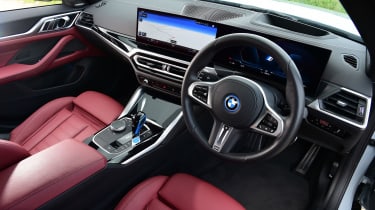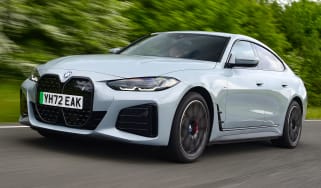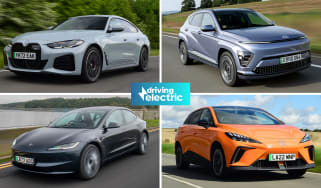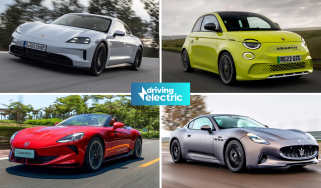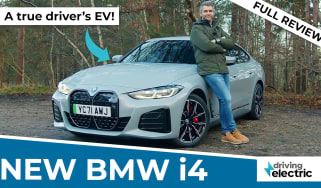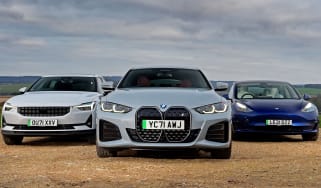BMW i4 review
The electric equivalent to the BMW 3 Series offers performance and refinement, plus technology and superb build quality
Pros
- Slick infotainment
- Competitive range
- Thoroughly engaging drive
Cons
- Expensive compared to rivals
- Tight rear-middle seat
- Only top models are four-wheel-drive
| Model | Range | Wallbox charging time | Rapid charge time |
|---|---|---|---|
| eDrive35 | 299 miles | 10hrs 45mins (0-100%, 7.4kW) | 32mins (10-80%, 180kW) |
| eDrive40 | 365 miles | 13hrs (0-100%, 7.4kW) | 31mins (10-80%, 205kW) |
| M50 | 318 miles | 13hrs (0-100%, 7.4kW) | 31mins (10-80%, 205kW) |
BMW i4 verdict
Can an electric car be the Ultimate Driving Machine? Well, the BMW i4 answers this question with a resounding ‘YES’, impressing thanks to its sharp steering, composed chassis and brisk electric motors. Essentially a 4 Series Gran Coupe with a Greta Thunberg-friendly electric powertrain, the i4 gets the same premium-feeling interior as its petrol cousin, plus an identical hatchback tailgate for easy loading of luggage. Sitting in the middle-rear seat feels a little bit like being perched on a bar stool and the electric Beemer isn’t exactly cheap to buy, either. But with the dynamic ability to rival the Porsche Taycan, the BMW i4 is a greatly desirable package and one of the most rounded premium EVs you can buy.
Range details, specs and alternatives
BMW’s electric car lineup is growing almost as fast as its iconic kidney grilles, with the Bavarian automaker’s lineup now ranging from the baby iX1 SUV, all the way to the new BMW i7 limousine.
The BMW i4 slots somewhere in the middle, essentially acting as the 3 Series of the ‘i-badged’ EV range. It shares more in common with the 4 Series Gran Coupe, though, with a hatchback tailgate at the rear and a sloping roofline – the latter no doubt helping the all-important range figure.
While SUVs have been taking the spotlight for a while now, the electric saloon market is a growing one, with the i4 butting heads with the likes of the Hyundai Ioniq 6, Tesla Model 3, Polestar 2 and the forthcoming Volkswagen ID.7.
The BMW i4 is available with three distinct powertrain setups: the first, introduced in 2023, is the entry-level i4 eDrive35. This utilises a 67kWh (usable) battery, alongside a 282bhp rear-mounted electric motor to get from 0-62mph in six seconds flat. Perhaps more importantly, BMW says even the base i4 will do 299 miles, which should be more than enough for the majority of buyers.
If you’re looking to cover a lot of miles frequently, then you’ll probably be best stepping up to the mid-spec i4 eDrive40. This not only gets a more powerful 335bhp motor, slashing the 0-62mph time to just 5.6 seconds, but a larger 81kWh (usable) battery extends range to a maximum of 365 miles.
Finally, there’s the high-performance BMW i4 M50 which was the first-ever electric car to be fettled with by BMW’s sporting ‘M’ division. This gets an additional motor on the front axle to provide (a predominantly rear-biased) four-wheel drive system and a combined output of 537bhp – 0-62mph takes a just 3.9 seconds and thanks to the same 81kWh battery pack as the eDrive40, range still stands at a respectable 318 miles.
While the BMW i4 M50 can almost be seen as a separate model in and of itself, the remainder of the i4 lineup can be configured in two trim levels: Sport and M Sport. Even base cars come well-equipped – something that’s not a given for a premium German saloon – and boast 18-inch alloy wheels, a powered tailgate, LED lights all round, a 14-inch touchscreen and 12-inch driver’s display, plus Apple CarPlay and Android Auto smartphone connectivity. We suspect most will pine after the sportier bodykit, 19-inch rims and adaptive suspension of M Sport models, though, and will inevitably fork out the £1,500 difference, overlooking the slightly reduced range it all brings.
Click here to see why you can trust DrivingElectric reviews, or for a more detailed look at the BMW i4, keep reading for the rest of our in-depth review…

